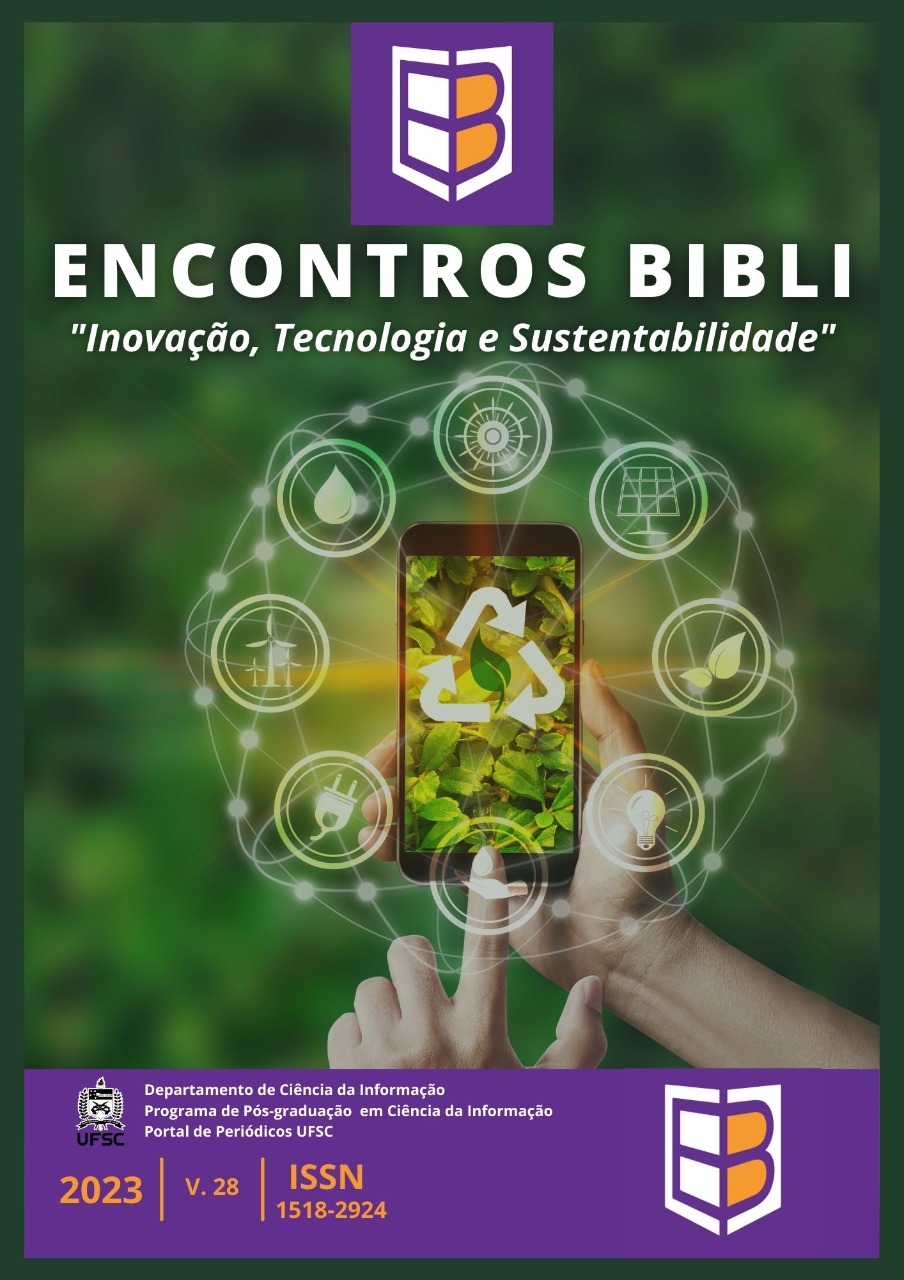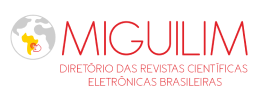Concentración de autoría en revistas de ciencias de la salud en América Latina y el Caribe
DOI:
https://doi.org/10.5007/1518-2924.2023.e91456Palabras clave:
Publicaciones periódicas como tema, Bibliometría, Autoría, Universidades, América Latina, Región del Caribe, Países en Desarrollo, LILACS, Ciencias de la saludResumen
Objetivo: describir los índices de concentración de autoría (proporción de artículos del autor más prolífico [PPMP]; coeficiente de Gini) entre las revistas de Ciencias de la Salud indexadas en LILACS, y compararlos con lo encontrado en un estudio previo en MEDLINE.
Métodos: se obtuvieron datos bibliográficos de LILACS de revistas indexadas sistemáticamente con al menos 50 artículos firmados (es decir, con al menos un autor individual) de 2015 a 2019. Los autores se identificaron por nombre o, cuando fue posible, por identificación ORCID. El PPMP fue el número de artículos del autor más prolífico de la revista, dividido por el número de artículos firmados. El coeficiente de Gini contó artículos con múltiples autores más de una vez. Con fines de comparación, los datos de MEDLINE se volvieron a ponderar para tener la misma distribución de tamaño de revista (número de artículos suscritos) que las revistas LILACS.
Resultados: el estudio incluyó 568 revistas, con una media de 166 artículos firmados. El MPPP fue 4,5% (percentil 95 12,9%) y el coeficiente de Gini fue 0,149 (percentil 95 0,310). PPMP aumentó con el tamaño de la revista, mientras que el coeficiente de Gini disminuyó. Las revistas de MEDLINE tenían un PPMP más bajo y un coeficiente de Gini más alto, pero esta diferencia desapareció después de volver a ponderar los datos.
Conclusiones: los criterios de inclusión de LILACS están neutralizando efectivamente cualquier efecto pro-endogeneidad atribuible a las revistas regionales que están siendo publicadas por las universidades. La evaluación de las revistas debe tener en cuenta el tamaño de la revista al examinar los índices de concentración de autoría. La derivación formal de su relación con el tamaño de la revista permitiría una interpretación más precisa de tales índices.
Descargas
Citas
AMORIM, K. M. DE O. et al. Evaluation Systems of Scientific Journals in Latin America. In: ALPERÍN, J. P.; FISCHMAN, G. (ed.). Made in Latin America: open access, scholarly journals, and regional innovations. Ciudad Autónoma de Buenos Aires: CLACSO, 2015. p. 61–74.
BARRADAS, J. S.; PINHEIRO, L. V. R. Produtividade científica em defesa nacional. Tendências da Pesquisa Brasileira em Ciência da Informação, [s. l.] v. 9, n. 2, p. 1-21, set./dez., 2016. Disponível em: https://revistas.ancib.org/index.php/tpbci/article/view/394/394. Acesso em: 17 ago. 2021
BEIGEL, F. et al. OLIVA: una mirada transversal a la producción científica indexada en América Latina. Diversidad disciplinar, colaboración institucional y multilingüismo en SciELO y Redalyc. [S. l.: s.n.], [2021?]. Disponível em: https://preprints.scielo.org/index.php/scielo/preprint/view/2653/version/2808. Acesso em: 17 ago. 2021.
BISHOP, D. V. M. Editorial integrity: Publishers on the front line. BishopBlog, 11 jun. 2016. Disponível em: http://deevybee.blogspot.com/2016/06/editorial-integrity-publishers-on-front.html. Acesso em: 18 maio 2023
BISHOP, D. V. M. “Percent by most prolific” author score: a red flag for possible editorial bias. BishopBlog, 12 jul. 2020.
Disponível em: http://deevybee.blogspot.com/2020/07/percent-by-most-prolific-author-score.html. Acesso em: 18 maio. 2023
BOAS, R. F. F.; CAMPOS, F. DE F.; AMARO, B. Análise dos critérios formais de qualidade editorial: a política de classificação de periódicos científicos a partir do Qualis Periódicos. Informação & Informação, Londrina, v. 26, n. 1, p. 28-52, 2021. Disponível em: https://ojs.uel.br/revistas/uel/index.php/informacao/article/view/39985. Acesso em: 18 maio 2023.
CLARK, O. A. C.; CASTRO, A. A. Searching the Literatura Latino Americana e do Caribe em Ciências da Saúde (LILACS) database improves systematic reviews. International Journal of Epidemiology, [s. l.] v. 31, n. 1, p. 112-114, fev. 2002. Disponível em: https://pubmed.ncbi.nlm.nih.gov/11914305/. Acesso em: 18 maio 2023.
COUNCIL OF SCIENCE EDITORS. CSE’s White Paper on Promoting Integrity in Scientific Journal Publications. Wheat Ridge: Council of Science Editors, 2018. Disponível em: http://www.seaairweb.info/journal/3.CouncilofScientific-Editors-White-Paper.pdf. Acesso em: 18 maio 2023.
DAVIDSON, R. Reliable inference for the Gini index. Journal of Econometrics, [s. l.], v. 150, n. 1, p. 30-40, maio 2009. Disponível em: https://www.sciencedirect.com/science/article/abs/pii/S0304407609000323. Acesso em: 18 maio 2023.
FISCHMAN, G. E.; ALPERIN, J. P.; WILLINSKY, J. Visibility and Quality in Spanish-Language Latin American Scholarly Publishing. Information Technologies & International Development, [S. l.], v. 6, n. 4, p. 1–21, dez. 2010. Disponível em: https://itidjournal.org/index.php/itid/article/view/639.html. Acesso em: 18 maio 2023.
FONTENELLE, L. F. leofontenelle/authorship-concentration: Improved analytic code for “Authorship concentration in health sciences journals from Latin America and the Caribbean”. Zenodo, 28 set. 2022. Disponível em: https://zenodo.org/record/7121200. Acesso em: 28 set. 2022.
GAGOLEWSKI, M. Stringi: Fast and Portable Character String Processing in R. Journal of Statistical Software, [s. l.], v. 103, n. 2, 2022. Disponível em: https://www.jstatsoft.org/article/view/v103i02. Acesso em: 28 set. 2022.
HELGESSON, G. et al. Editors publishing in their own journals: A systematic review of prevalence and a discussion of normative aspects. Learned Publishing, [s. l.], v. 35, n. 2, p. 229-240, 2022. Disponível em: https://onlinelibrary.wiley.com/doi/full/10.1002/leap.1449. Acesso em: 28 set. 2022.
INTERNATIONAL COMMITTEE OF MEDICAL JOURNAL EDITORS. Recommendations for the Conduct, Reporting, Editing, and Publication of Scholarly Work in Medical Journals. [S. l.], dez. 2021. Disponível em: http://www.icmje.org/recommendations/. Acesso em: 11 fev. 2022
JASSO, G. On Gini’s Mean Difference and Gini’s Index of Concentration. American Sociological Review, [s. l.], v. 44, n. 5, p. 867–870, 1979. Disponível em: https://www.jstor.org/stable/2094535. Acesso em: 11 fev. 2022.
LATIN AMERICAN AND CARIBBEAN CENTER ON HEALTH SCIENCES INFORMATION. LILACS – Criterios de Selección y Permanencia de Revistas (2020). São Paulo, 2020. Disponível em: https://lilacs.bvsalud.org/es/revistas-lilacs/lilacs-criterios-de-seleccion-y-permanencia-de-revistas-2020/. Acesso em: 18 maio. 2023.
LATIN AMERICAN AND CARIBBEAN CENTER ON HEALTH SCIENCES INFORMATION. Criteria for Selection and Permanence of Journals LILACS Brazil (2021). São Paulo, 2021. Disponível em: https://lilacs.bvsalud.org/en/lilacs-journals/criteria-for-selection-and-permanence-of-journals-lilacs-brazil-2021/. Acesso em: 18 maio. 2023.
LOCHER, C. et al. Publication by association: how the COVID-19 pandemic has shown relationships between authors and editorial board members in the field of infectious diseases. BMJ Evidence-Based Medicine, [S. l.], p. bmjebm-2021-111670, 2021. Disponível em: https://ebm.bmj.com/content/27/3/133. Acesso em: 18 maio. 2023.
MOUSSA, S. Should editors-in-chief publish in their own journals? “Publish elsewhere” is not a solution. European Science Editing, [S. l.], v. 48, p. e90552, 2022. Disponível em: https://ese.arphahub.com/article/90552/. Acesso em: 18 maio. 2023.
PAZ ENRIQUE, L. E.; PERALTA GONZÁLEZ, M. J.; HERNÁNDEZ ALFONSO, E. A. Estudio bibliométrico de la Revista Centro Agrícola, Cuba. e-Ciencias de la Información, [s. l.], v. 6, n. 2, p. 1, jun. 2016. Disponível em: https://www.redalyc.org/journal/4768/476852098002/html/. Acesso em: 18 maio. 2023.
PYATT, G. On the Interpretation and Disaggregation of Gini Coefficients. The Economic Journal, [s. l.], v. 86, n. 342, p. 243-255, 1976. Disponível em: https://www.jstor.org/stable/2230745. Acesso em: 18 maio 2023.
R CORE TEAM. R: A Language and Environment for Statistical Computing. Vienna, Austria: R Foundation for Statistical Computing, 2022.
ROZEMBLUM, C. et al. Calidad editorial y calidad científica en los parámetros para inclusión de revistas científicas en bases de datos en Acceso Abierto y comerciales. Palabra Clave (La Plata), La Plata, v. 4, n. 2, p. 64-80, abr. 2015. Disponível em: https://www.redalyc.org/pdf/3505/350539940001.pdf. Acesso em: 18 maio 2023.
SARIGÖL, E. et al. Quantifying the effect of editor-author relations on manuscript handling times. Scientometrics, [s. l.], v. 113, n. 1, p. 609-631, 2017. Disponível em: https://pubmed.ncbi.nlm.nih.gov/29056793/. Acesso em: 18 maio 2023.
SCANFF, A. et al. A survey of biomedical journals to detect editorial bias and nepotistic behavior. PLOS Biology, [s. l.], v. 19, n. 11, p. e3001133, nov. 2021. Disponível em: https://journals.plos.org/plosbiology/article?id=10.1371/journal.pbio.3001133. Acesso em: 18 maio 2023.
WICKHAM, H. Ggplot2: Elegant Graphics for Data Analysis. 2 nd. [S.l.]: Springer-Verlag New York, 2016.
WORLD ORGANIZATION OF MEDICAL EDITORS. The Relationship Between Journal Editors-in-Chief and Owners. [S. l.], 2009. Disponível em: https://wame.org/editorial-independence. Acesso em: 11 fev. 2022.
Descargas
Publicado
Cómo citar
Número
Sección
Licencia
Derechos de autor 2023 Leonardo Ferreira Fontenelle

Esta obra está bajo una licencia internacional Creative Commons Atribución 4.0.
El autor debe garantizar:
que existe un consenso total de todos los coautores para aprobar la versión final del documento y su presentación para su publicación.
que su trabajo es original, y si se han utilizado el trabajo y / o las palabras de otras personas, estos se han reconocido correctamente.
El plagio en todas sus formas constituye un comportamiento editorial poco ético y es inaceptable. Encontros Bibli se reserva el derecho de utilizar software o cualquier otro método para detectar plagio.
Todas las presentaciones recibidas para su evaluación en la revista Encontros Bibli: revista electrónica de biblioteconomía y ciencias de la información pasan por la identificación del plagio y el auto-plagio. El plagio identificado en los manuscritos durante el proceso de evaluación dará como resultado la presentación de la presentación. En el caso de identificación de plagio en un manuscrito publicado en la revista, el Editor en Jefe llevará a cabo una investigación preliminar y, si es necesario, la retractará.
Esta revista, siguiendo las recomendaciones del movimiento de Acceso Abierto, proporciona su contenido en Acceso Abierto Completo. Por lo tanto, los autores conservan todos sus derechos, permitiendo a Encontros Bibli publicar sus artículos y ponerlos a disposición de toda la comunidad.
Los contenidos de Encontros Bibli están licenciados bajo Licencia Creative Commons 4.0.

Cualquier usuario tiene derecho a:
- Compartir: copiar, descargar, imprimir o redistribuir material en cualquier medio o formato
- Adaptar: mezclar, transformar y crear a partir del material para cualquier propósito, incluso comercial.
De acuerdo con los siguientes términos:
- Atribución: debe otorgar el crédito apropiado, proporcionar un enlace a la licencia e indicar si se han realizado cambios. Debe hacerlo bajo cualquier circunstancia razonable, pero de ninguna manera sugeriría que el licenciante lo respalde a usted o su uso.
- Sin restricciones adicionales: no puede aplicar términos legales o medidas tecnológicas que restrinjan legalmente a otros de hacer cualquier cosa que permita la licencia.

























